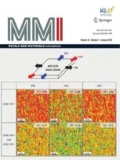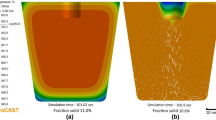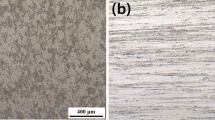Abstract
An investigation was carried out on the grain refinement of molten AA5754 Aluminum alloy through intensive shearing. The results show intensive shearing via cavitation decreases the grain size significantly. The above hypothesis for structure refinement was evaluated and an experiment was performed to ensure the creditability of this assumption. Finally, it was simulated by computational fluid dynamics (CFD) modeling. It was understood that shearing is the responsible mechanism for creation of cavitation bubbles and further collapse of them. It was also concluded the pressure which generated from the collapse of the bubble is well enough for braking the oxide layer and wetting them. It was proved that breaking of the oxide layer wets the impurity particles upon collapse of cavitation bubbles and provides additional nuclei and additional grain refinement. The suggested mechanism includes improved wetting by breaking the oxide layer through fatigue via continuous hitting of the micro-jets, local undercooling upon the collapse of cavitation bubbles, and pre-solidification inside fine capillaries.
Similar content being viewed by others
References
A. L. Greer, Phil. Trans. Math. Phys. Eng. Sci. 361, 479, (2003).
J. P. Gabathuler and D. Barras, 2nd International Conference on Semisolid Processing of Alloys and Composites (eds. S.B. Brown, M.C. Flemings) p. 33, MIT/Boston, USA (1992).
C. Vives, Metall. Trans. B 23, 189 (1992).
Z. Fan, S. Ji and M. J. Bevis, PCT Patent, WO02/13993A1 (2000).
D. G. Eskin, Zeitschrift für Metallkunde 87, 295 (1996).
Z. Fan, Y. Wang, Z. F. Zhang, M. Xia, H. T. Li, J. Xu, L. Granasy, and G. M. Scamans, Int. J. Cast. Met. Res. 22, 1 (2009).
L. Nastac, 2012 IOP Conf. Ser.: Mater. Sci. Eng. 33, 012079 (2012).
N. Eustathopoulos and B. Drevet, Mater. Sci. Eng. A 249, 176 (1998).
C. E. Brennen, Cavitation & Bubble Dynamics, pp.112–124, Oxford University Press, Oxford, UK (1995).
G. I. Eskin and D. G. Eskin, Zeitschrift für Metallkunde 95, 682, (2004).
R. Haghayeghi, E.J. Zoqui, and H. Bahai, J. Alloys Compd. 481, 358, 2009.
ASTM, Standard Test for Determining Average Grain Size, p.256, ASTM International, PA, USA (2002).
J. Lyman and J. Briggs, Appl. Phys. 21, 721 (1950).
M. H. Zimmerman, Sci. Amer. 208, 133 (1963).
G. Eskin, Ultrasonics Sonochemistry 2, S137 (1995).
R. Haghayeghi, Met. Mater. Int. 18, 777 (2012).
I. G. Brodova, P. S. Popel, and G. I. Eskin, Liquid Metal Processing, pp.147–192, Taylor & Francis, London (2002).
W.M. Haynes, The CRC Handbook of Chemistry and Physics, 93th ed., pp.1126–1287, CRC Press, Canberra, Australia (2006).
G. I. Eskin, Ultrasonic Treatment of Light Alloy Melts, pp.1–334, Gordon & Breach Science Publisher, Amsterdam (1998).
L. I. Jiang and C. Hao-sheng, Tribology 28, 311 (2008).
M. Sussman, J. Comp. Phys. 187, 110 (2003).
Fluent Incorporation, Gambit Tutorial Guide, Release 2.4.6, pp.1–305, Lebanon, NH 03766, USA (2000).
ANSYS INC., ANSYS Release 14.0, Coupled Field Analysis Guide, pp.1–162. ANSYS Inc. (2007).
S. Zeleski, Modelling Simulation and Design in Process Engineering, (eds. E.D. Gilles), p.97, SFB-Kolloquim, Stuttgart (s1999).
J. U. Brackbill, D. B. Kothe, and C. Zemach, J. Comp. Phys. 100, 335 (1992).
C. H. Yeh and W. J. Yang, J. Appl. Phys. 19, 3156 (1968).
J. F. Shackelford and W. Alexander, CRC Materials Science and Engineering Handbook, pp.406–509, CRC Press (2000).
D. Basu, Sadhana 28, 589 (2003).
Author information
Authors and Affiliations
Corresponding author
Additional information
An erratum to this article is available at http://dx.doi.org/10.1007/s12540-016-0001-z.
Rights and permissions
About this article
Cite this article
Haghayeghi, R., Ezzatneshan, E., Bahai, H. et al. Numerical and experimental investigation of the grain refinement of liquid metals through cavitation processing. Met. Mater. Int. 19, 959–967 (2013). https://doi.org/10.1007/s12540-013-5008-0
Received:
Accepted:
Published:
Issue Date:
DOI: https://doi.org/10.1007/s12540-013-5008-0




